Ashbourne, Meath
| Ashbourne Irish: Cill Dhéagláin | |
| Meath | |
|---|---|
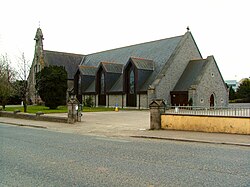 Church of the Immaculate Conception, Ashbourne | |
| Location | |
| Grid reference: | O060525 |
| Location: | 53°30’43"N, 6°23’53"W |
| Data | |
| Population: | 14,019 (2011[1]) |
| Post town: | Ashbourne |
| Postcode: | A84 |
| Local Government | |
| Council: | Meath |
| Dáil constituency: |
Meath East |
Ashbourne is a town in Meath, close to the border with the county of Dublin. Located about 12½ miles north of Dublin, it is bypassed on the western side by the M2 motorway. The town has historically been called Killeglan or Kildeglan,[2] from the Irish Cill Dhéagláin, meaning "Déaglán's church".
History
Recent archaeological excavations in the area around Ashbourne have revealed evidence of settlement back to neolithic times. In the townland of Rath, to the north of the town centre, a Bronze Age settlement was found during the construction of the M2 motorway. Excavations in the vicinity of the cemetery Killegland revealed the extent of the early Christian settlement, with souterrains, house sites and a large enclosure centred around the remains of the church that is visible in the cemetery. This would link the townland name of Killegland - meaning Declan's Church - to pre-Patrician settlement in the area. Archaeological excavations on the site of a supermarket revealed the original mediæval town, with several house remains, associated field systems, fish traps and mill races.
Hugh de Lacy, Lord of Meath, set about building fortified houses, called mottes and baileys, in case the native Irish would regroup and attack. The remains of a motte and bailey can be found in Ratoath, three miles from Ashbourne.
Once settled, Hugh de Lacy divided the land among his army. A large portion at Killeglan was given to a family called Wafre in 1220. This family lived there until 1420, the last member of this family having built a tower house (a fortified house often called a castle). The castle and lands became the property of the Segrave family, who remained owners until 1649. The first of the family recorded in Meath, Richard Sydgrave, was Chief Baron of the Irish Exchequer 1423-5. They became one of the most influential and wealthy non-aristocratic families in Ireland during the 16th century, with two gaining the high political office of Chancellor of the Exchequer, while another became High Sheriff of Meath; Richard Segrave (died 1598) and his son Patrick Segrave were both judges of the Court of Exchequer.
However, their political power and possessions were removed during the religious wars of 1641 to 1650. Indeed, during the Cromwellian period, Oliver Cromwell's son, Henry, stayed for a time in Killeglan Castle. With the final subjugation of the native Irish after 1690, and the imposition of religious persecution in the Penal Laws, a new land-owner named Thomas Carter gained possession of the Killeglan lands. He did not live there, and the castle fell into dis-repair and eventually into ruin. The Carter family held high office in Irish politics during the 18th century but their fortunes waned in the early 19th century. When the Carter estates were sold in the 1840s, the Killegland lands were bought by Frederick Bourne.
Frederick Bourne was a rich entrepreneur who made his fortune from roads and transport. Before 1820 in Ireland roads were almost non-existent. Government regulations allowed for considerable spending on roads, and the subsequent improvements ensured greater post-coach services. Bourne owned a coach company and financed road-building, collecting revenue from tolls. He financed a ten-mile (old Irish miles) section of road from Dublin to Killegland. He decided to build a small town with an inn, a hotel and other small businesses to make money from travellers. He built this village near his ten-mile tollbooth and named the place after his favourite tree, and himself, i.e. Ash and Bourne. This began in 1820.
Bourne's idea was a great success. However, by 1850 rail was taking business from the roadways, and the Bourne family fortune declined. In 1821 the population was 133, by 1841 it was 411. Unfortunately the Great Famine took its toll from 1845 to 1851, and the population declined. Frederick Bourne left his land at Killegland, and his village of Ashbourne, to his son Richard in 1844. Richard lived in the village, and his first home is now the Ashbourne House Hotel on Frederick Street. Later he built a modest house down Castle Street near where the last remains of the Wafre and Segrave tower house were. Richard married the daughter of a wealthy local family, Elizabeth Mangan, and had several children. The eldest, Thomas, became his father's heir and the last landlord of Ashbourne. He left Ireland and went to live in Northfleet, Kent, in 1899. The land was sold to the local tenants.
Population growth
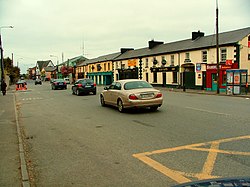
Ashbourne was a small village with a population under 400 until 1970. Then, in response to the growing population of nearby Dublin, a new scheme of houses was built in Ashbourne, based on the American open plan scheme rather than with fenced-off gardens. This was new in Ireland. The population of the town was 8,528 as of the 2006 census, a 34% increase on the previous census in 2002,The population in the year 2013 was recorded at 14,000 people approximately, making it Meath's second largest town after Navan.
This growth has largely been the result of the rapid construction of several new housing schemes - most notably several apartment blocks scattered throughout the town and a number of new housing estates. It's also led to Ashbourne becoming a cosmopolitan town, the 2006 census showed[3] that over 12% of Ashbourne's population was born outside Ireland. The Lithuanian community is the second largest minority in Ashbourne after people from the United Kingdom. Almost one fifth of all non-Irish born in the town are from Lithuania. Lithuanian language services are held in the Church of the Immaculate Conception. The Polish community in Ashbourne is the second-largest in Meath after Navan.
The growth in Ashbourne's population has spurred expansion of local enterprise and retail to cater for the growing populations needs. Many new retail units have been opened in recent years.
Public transport
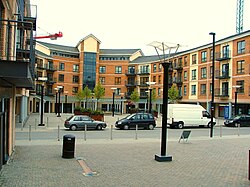
Ashbourne is served by an express coach service direct to Dublin. Some of these services continue on to Ratoath, Kilmoon Cross and Duleek. At the beginning of March 2010, a regular service to and from Navan via Dunshaughlin and Ratoath to Dublin Airport that had previously not passed through Ashbourne was rerouted to serve the Marriott Hotel at the northern end of the town, and to then go through the town to the airport and Dublin City University. The service (route 109A) runs every hour from early morning to late evening. The 104 service that ran from Ashbourne to Blanchardstown Shopping centre was discontinued at the same time, and replaced by some of the 105 service being extended from Ratoath to also serve Ashbourne.
Amenities
There is an 18-hole golf course on the outskirts of the town and several sports clubs in the town, including a Gaelic Athletic Association club, Donaghmore-Ashbourne who have recently built a new clubhouse, with an indoor astro turf and two full-size Gaelic pitches. There is also a rugby union team who play their matches at the Ashbourne rugby club which has also undergone some development with the creation of a new rugby pitch and a small astro pitch which can also be used for five-a-side football. There is also an association football team Ashbourne United, a cricket club, and a judo club, as well as other sporting organisations. There is a community centre which has a big hall and some squash courts. The community centre is used by many of the sporting organisations such as the St Andrews athletics club (who also have facilities in the Arkle Pavilion in Greenogue on the outskirts of Ashbourne), Ashbourne Archers, set up in June 2014 run archery training courses and weekly (Tuesday evenings) shoots in indoor hall in Donaghmore Ashbourne GAA. Fairyhouse Racecourse is located six miles from Ashbourne. Fairyhouse attracts leading horses both on the flat and over jumps. Tayto Park has been opened since 2010 and offers over 50 acres of activities for children, all themed around Mr. Tayto and his crisps; the park is now open to one of Europe's largest wooden roller coasters, which opened in June 2015. An international standard sized baseball field opened in August 2015 and is home to Ashbourne Giants baseball club and Baseball Ireland.
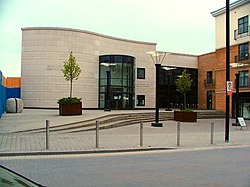
Retail activities
A series of shopping streets are have been built as part of a scheme to give Ashbourne the type of retail centre more in keeping with other towns, these shopping facilities are in Ashbourne High Street and the crescent. Up until recently commercial development in the town was stifled given the fact that the town was bisected by a busy national primary route, the N2, on to which all commercial development was focused. This restricted the town's potential to attract high street retailers due to the a lack of suitable sites and the associated traffic hazards of the N2. In 2002, a local area plan for the town was completed which provides for the future development of Ashbourne. The plan provided for a major expansion of Ashbourne westward into the townland of Killegland adjoining the new N2 Ashbourne bypass. It led to the introduction of residential units, a retail park, community facilities and industrial units. The town is being planned westward, further into Meath, as the Dublin County boundary is only a mile from the east side of the town, which decreases to approximately 2,000 ft> at the north end of the town, in the townland of Rath.
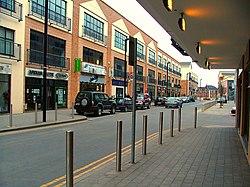
Of the streets developed in Ashbourne's "new" town centre, Killegland Street, has become a new commercial street containing a number of varied retail units along with a new library and council offices. Car parking in the town has been expanded thanks to both a large underground car park beneath Killegland Street (extending from Tesco to the Civic Offices) and a multi-storey car park above the retail units on the south end of the street.
Bridge Street is an existing street between the Broadmeadow River and the Ashbourne House Hotel which contained just three dwellings and no retail outlets eight years ago now has five shops, a large hotel, dozens of apartments and a supermarket there. This is typical of the high pace of development in Ashbourne in the past decade.
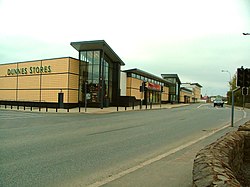
A large supermarket has opened a large store on the former Dardis & Dunns seed merchant site on the northern end of Frederick/Main Street as part of the Ashbourne Town Centre development and is accessible from both Frederick Street, across from Ashbourne's original town centre and Killegland Square, linking the new retail area to the established centre in the town.
Future retail activities and developments
Development is now being concentrated on the area west of Castle Street (known locally as Ned Nulty's Lane), a route which was completely realigned and widened in 2006 to allow motorists to avoid the new centre and reduce congestion, as well as providing a direct route from Garden City to Cluain Rí and areas like Brindley Park and Johnswood. However, in the medium to long-term, this route will lead to the new housing developments to the west of the town centre/Crestwood/Bourne View areas. It's expected that this end of town, which is now home to Donaghmore-Ashbourne GAA's new playing pitches, will eventually stretch to the N2 bypass to the west and join with Brindley Park to the north.
2007 also saw the opening of two new commercial ventures in the Rath, north of the town. 4Home Superstores opened in February 2007, at the new Ashbourne Retail Park and catalogue store Argos opened an Argos Extra outlet in the park in August 2007. Meath's second Marriott hotel opened in April 2007 as the 148-room Ashbourne Marriott.It is now known as the Pillo hotel.
Ashbourne Retail Park Ltd. applied for planning permission[4] on 9 March 2007 for an extension to the park, consisting of 4 additional double-height retail warehouse units, with a 1,000 seater cinema overhead as well as food and beverage outlets. Car parking was also to increase by another 210 spaces, with the entire extension containing almost 7,500 sq. m of floor area.
The town's first cinema opened in Ashbourne Retail Park on 19 June 2009. The Sunday Tribune reported that the six-screen, 1,000-seat facility, which is Showtime Cinemas' first opening, has wall-to-wall screens, rocker seats, full digital projection and 3D capability.
M2
Ashbourne is linked to the M50 and Dublin by 10 miles of motorway/high quality dual carriageway on the N2/M2 national primary route, which commences at junction 5 of the M50 motorway (8½ miles from Ashbourne). The road is a six-lane dual-carriageway from the M50 until exit 2, Cherryhound in Co. Dublin, where it becomes a motorway from there to the Rath roundabout, a mile north of Ashbourne. The M2 incorporates a bypass of Ashbourne.
The N2 dual-carriageway, on its opening in 2006, was unique in Ireland as it was the first non-motorway road in the state to officially be granted national motorway speed limits of 120 km/h without any motorway restrictions. As a de-facto motorway, many referred to this route as the M2 but this situation was regularised on 28 August 2009, when the section between exit 2 and the Rath roundabout north of Ashbourne was redesignated as a motorway. The old N2, now re-designated the R135, had its speed limit reduced to 80 km/h in Co. Meath and 60 km/h in adjoining Co. Dublin, much to the consternation of local motorists.
The N2/M2, which the Government announced in March 2005 would not be tolled, allows thousands of commuters and hauliers to avoid the town, which has become a major bottleneck for traffic heading south from the counties of Donegal, Londonderry, Tyrone, Monaghan, Lough and the rest of Meath. The South Ashbourne Interchange, a large junction taking traffic on and off the N2 near the Nine Mile Stone, allows non-stop transferral of traffic to and from Ashbourne and its new by-pass. Phase II of the M50 upgrade, opened in 2010, links the N2 to the M50 at exit 5 with a partial freeflow junction, meaning most traffic transferring from the M50 to the N2 and vice versa does not have to stop (traffic lights remain where traffic from the M50 southbound meets traffic from the N2 southbound).
Notable Residents
- Patrick Donohoe, recipient of the Victoria Cross
- Johnny Logan - Eurovision Star
- Aengus Mac Grianna - RTÉ newsreader
References
- ↑ "Census 2006 – Volume 1 – Population Classified by Area" (PDF). Central Statistics Office Census 2006 Reports. Central Statistics Office Ireland. April 2007. Archived from the original on 7 June 2011. https://web.archive.org/web/20110607074609/http://www.cso.ie/census/documents/census2006_volume_1_pop_classified_by_area.pdf. Retrieved 2011-06-08.
- ↑ Placenames Database of Ireland (see archival records)
- ↑ Irish Social Science Data Archive (14 June 2007). "Theme 2 - 1: Usually resident population by place of birth (Census 2006)". 2006 Small Area Population Statistics (SAPS). Central Statistics Office of Ireland. http://beyond2020.cso.ie/Census/TableViewer/tableView.aspx?ReportId=2212. Retrieved 2007-07-18.
- ↑ "Meath County Council Planning Applications 05/03/07 to 11/03/07" (Doc file). Weekly Planning Permission Lists. Meath Tourism, Meath County Council. http://meathtourism.ie/LocalAuthorities/Planning/PlanningPermission/WeeklyPlanningPermissionLists/File,6512,en.doc. Retrieved 2007-07-18.
Outside links
| ("Wikimedia Commons" has material about Ashbourne, Meath) |
- Ashbourne business/community directory
- A short history of Ashbourne
- Meath Tourism website managed by Meath County Council, based in Ashbourne
- Meath Event Guide based in Ashbourne
- Showtime Cinemas Showtime Cinemas
